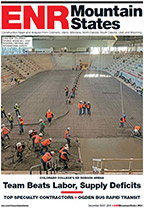By late August, as the sun set on one of the most scorching summers in U.S. history, it became clear that Monroe, Ohio-based Baker Concrete Construction Co. just might achieve its goal of registering zero OSHA recordable incidents of heat-related injury or illness this season, despite punishing conditions on sites such as that of the new Meldahl Hydroelectric Plant, located east of Cincinnati.
That's no small feat for the 10th-largest subcontractor in the nation (ENR 10/17/11 p. 67), whose territory extends from Phoenix to Fort Lauderdale, Fla., and from Washington, D.C., to Aurora, Colo.
"We weren't as fortunate last year," says Mike Schneider, Baker senior vice president and head of the firm's worker safety program. "So, we put a program in place to address the issue of heat-related injuries this past spring. It boils down to one guy looking after the other, so that if conditions warrant you pull that guy off the pour and get him into a trailer."
When the issue is safety, Baker hits its mark. In January the firm earned first place for safety excellence in the Associated General Contractors of Ohio's Construction Safety Excellence Award competition. In March, it earned second place in the specialty division—more than 1 million work hours category—at AGC's National competition in Hawaii.
Everyone Speaks Up
Neither Schneider nor Steve Martin, Baker's general manager for the Midwest region, mentions either competition, though both are eager to lay out the particulars of the firm's Incident and Injury-Free (IIF) program, which is responsible for the accolades.
"Do you have a wife?" asks Schneider. "A grandchild? If I see someone who's not tied off on a site, here's how I want to initiate a conversation: 'Aren't you and your wife going to the ball game tonight? Well, why don't you tie yourself off so you and your wife get to go and see it?'"
"Which means the foreman really needs to know the workers on his crew, so he can relate the issue of safety to family," says Martin.
"Not only the foreman," says Schneider. "Every worker on payroll has the right and responsibility to speak up." Schneider describes the program, initiated in January 2007, as a five-year journey propelled by an ethical credo. "We're not safe because we have to be, but because we want to be. We truly are our brothers' keepers."
Baker primarily focused on compliance-oriented OSHA training until 2006, when the firm bid on the $137-million, 545,000-sq-ft Atrium Medical Center in Middleton, Ohio, a joint venture between construction managers Skanska and Shook Construction. "Safety was the first word out of the Skanska super's mouth, even during the prequalification phase," Schneider recalls. He and his colleagues later learned that Skanska had implemented an IIF program comprised of courses such as supervisory skills training, an advanced class for foremen.









Post a comment to this article
Report Abusive Comment